Developing a Care Plan: Effective Management of Type 1 Diabetes
VerifiedAdded on 2023/06/13
|11
|3530
|395
Case Study
AI Summary
This case study provides a comprehensive care plan for managing type 1 diabetes in young children, focusing on the pathophysiology, diagnostic methods, and care management of the disorder. It discusses various diagnostic procedures, including random blood glucose tests, glycated hemoglobin tests (A1c), and autoantibody tests, to confirm the type of diabetes. The care plan emphasizes insulin management, detailing different types of insulin and delivery methods, along with the importance of individualized insulin regimens. It also highlights the significance of self-monitoring blood glucose levels and educating patients and parents about the procedure. Furthermore, the study underscores the need for dietary management and awareness of potential complications like diabetic ketoacidosis and gastroparesis, ensuring a holistic approach to managing type 1 diabetes in young children.
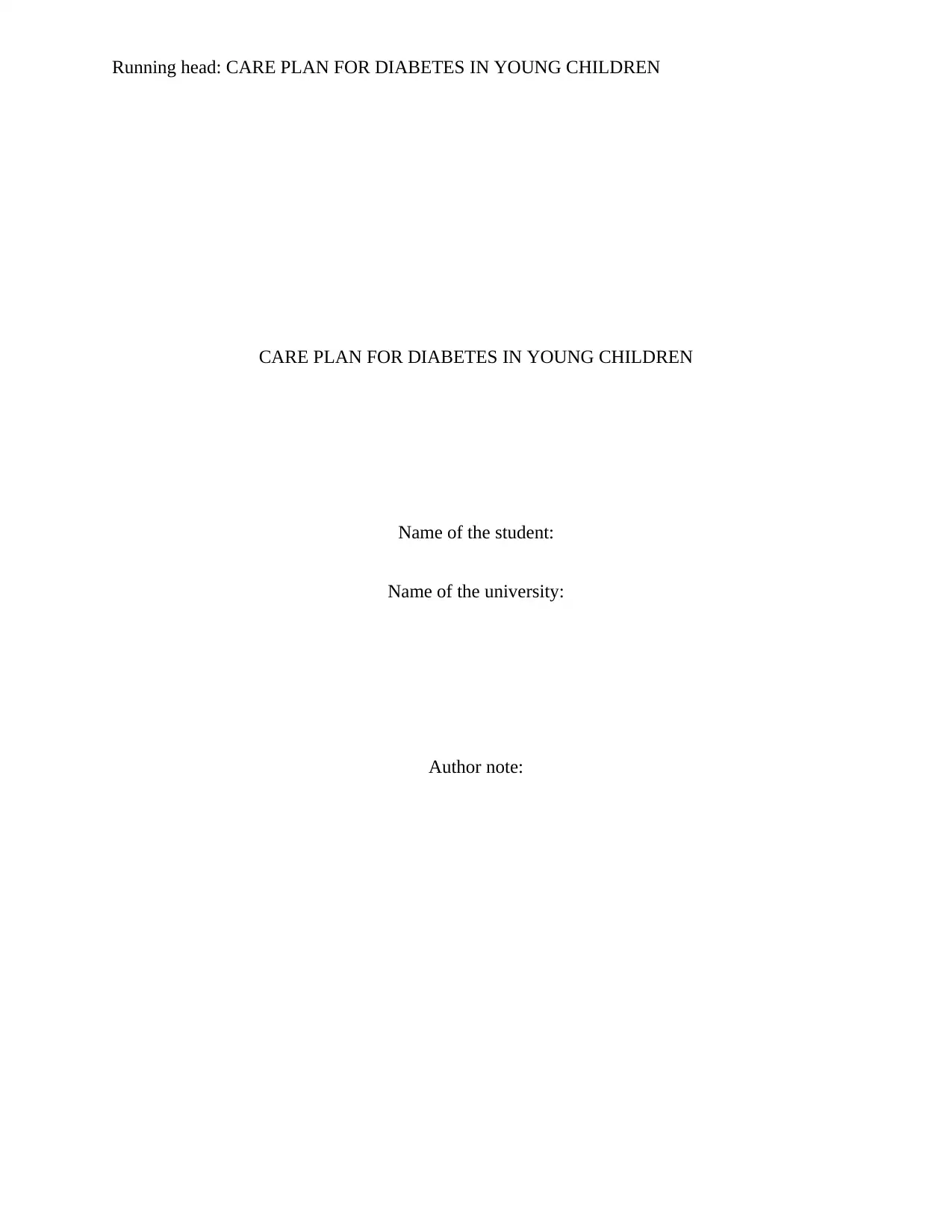
Running head: CARE PLAN FOR DIABETES IN YOUNG CHILDREN
CARE PLAN FOR DIABETES IN YOUNG CHILDREN
Name of the student:
Name of the university:
Author note:
CARE PLAN FOR DIABETES IN YOUNG CHILDREN
Name of the student:
Name of the university:
Author note:
Paraphrase This Document
Need a fresh take? Get an instant paraphrase of this document with our AI Paraphraser
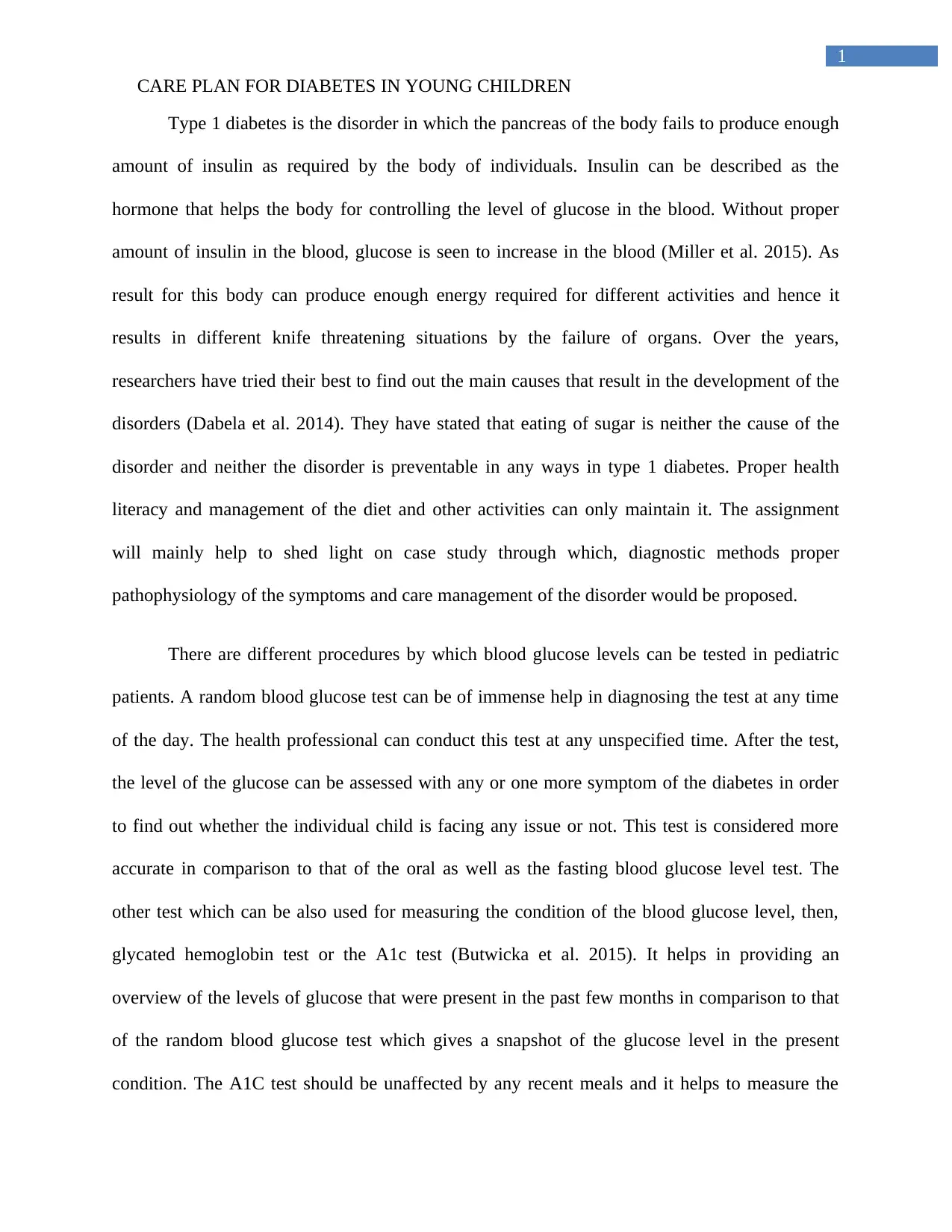
1
CARE PLAN FOR DIABETES IN YOUNG CHILDREN
Type 1 diabetes is the disorder in which the pancreas of the body fails to produce enough
amount of insulin as required by the body of individuals. Insulin can be described as the
hormone that helps the body for controlling the level of glucose in the blood. Without proper
amount of insulin in the blood, glucose is seen to increase in the blood (Miller et al. 2015). As
result for this body can produce enough energy required for different activities and hence it
results in different knife threatening situations by the failure of organs. Over the years,
researchers have tried their best to find out the main causes that result in the development of the
disorders (Dabela et al. 2014). They have stated that eating of sugar is neither the cause of the
disorder and neither the disorder is preventable in any ways in type 1 diabetes. Proper health
literacy and management of the diet and other activities can only maintain it. The assignment
will mainly help to shed light on case study through which, diagnostic methods proper
pathophysiology of the symptoms and care management of the disorder would be proposed.
There are different procedures by which blood glucose levels can be tested in pediatric
patients. A random blood glucose test can be of immense help in diagnosing the test at any time
of the day. The health professional can conduct this test at any unspecified time. After the test,
the level of the glucose can be assessed with any or one more symptom of the diabetes in order
to find out whether the individual child is facing any issue or not. This test is considered more
accurate in comparison to that of the oral as well as the fasting blood glucose level test. The
other test which can be also used for measuring the condition of the blood glucose level, then,
glycated hemoglobin test or the A1c test (Butwicka et al. 2015). It helps in providing an
overview of the levels of glucose that were present in the past few months in comparison to that
of the random blood glucose test which gives a snapshot of the glucose level in the present
condition. The A1C test should be unaffected by any recent meals and it helps to measure the
CARE PLAN FOR DIABETES IN YOUNG CHILDREN
Type 1 diabetes is the disorder in which the pancreas of the body fails to produce enough
amount of insulin as required by the body of individuals. Insulin can be described as the
hormone that helps the body for controlling the level of glucose in the blood. Without proper
amount of insulin in the blood, glucose is seen to increase in the blood (Miller et al. 2015). As
result for this body can produce enough energy required for different activities and hence it
results in different knife threatening situations by the failure of organs. Over the years,
researchers have tried their best to find out the main causes that result in the development of the
disorders (Dabela et al. 2014). They have stated that eating of sugar is neither the cause of the
disorder and neither the disorder is preventable in any ways in type 1 diabetes. Proper health
literacy and management of the diet and other activities can only maintain it. The assignment
will mainly help to shed light on case study through which, diagnostic methods proper
pathophysiology of the symptoms and care management of the disorder would be proposed.
There are different procedures by which blood glucose levels can be tested in pediatric
patients. A random blood glucose test can be of immense help in diagnosing the test at any time
of the day. The health professional can conduct this test at any unspecified time. After the test,
the level of the glucose can be assessed with any or one more symptom of the diabetes in order
to find out whether the individual child is facing any issue or not. This test is considered more
accurate in comparison to that of the oral as well as the fasting blood glucose level test. The
other test which can be also used for measuring the condition of the blood glucose level, then,
glycated hemoglobin test or the A1c test (Butwicka et al. 2015). It helps in providing an
overview of the levels of glucose that were present in the past few months in comparison to that
of the random blood glucose test which gives a snapshot of the glucose level in the present
condition. The A1C test should be unaffected by any recent meals and it helps to measure the
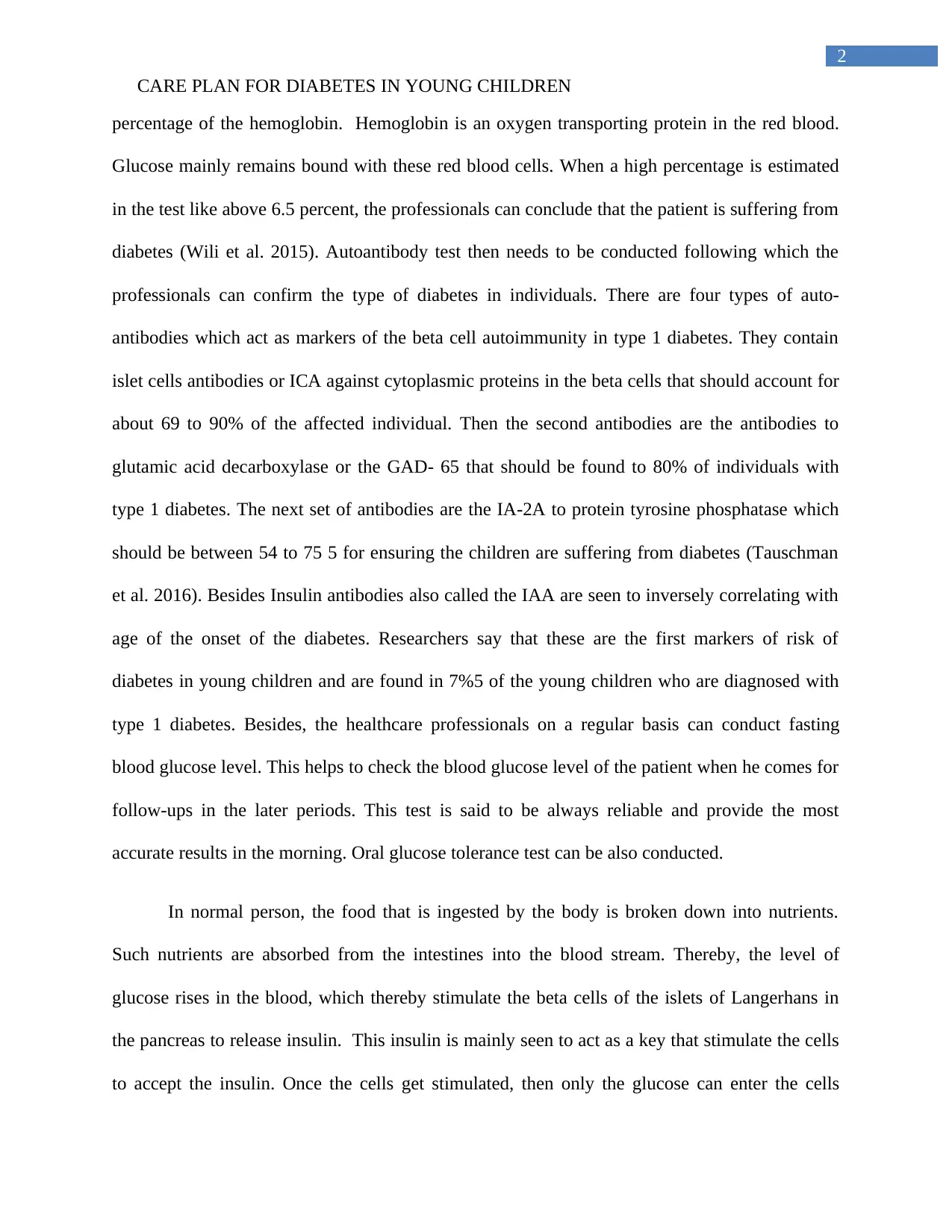
2
CARE PLAN FOR DIABETES IN YOUNG CHILDREN
percentage of the hemoglobin. Hemoglobin is an oxygen transporting protein in the red blood.
Glucose mainly remains bound with these red blood cells. When a high percentage is estimated
in the test like above 6.5 percent, the professionals can conclude that the patient is suffering from
diabetes (Wili et al. 2015). Autoantibody test then needs to be conducted following which the
professionals can confirm the type of diabetes in individuals. There are four types of auto-
antibodies which act as markers of the beta cell autoimmunity in type 1 diabetes. They contain
islet cells antibodies or ICA against cytoplasmic proteins in the beta cells that should account for
about 69 to 90% of the affected individual. Then the second antibodies are the antibodies to
glutamic acid decarboxylase or the GAD- 65 that should be found to 80% of individuals with
type 1 diabetes. The next set of antibodies are the IA-2A to protein tyrosine phosphatase which
should be between 54 to 75 5 for ensuring the children are suffering from diabetes (Tauschman
et al. 2016). Besides Insulin antibodies also called the IAA are seen to inversely correlating with
age of the onset of the diabetes. Researchers say that these are the first markers of risk of
diabetes in young children and are found in 7%5 of the young children who are diagnosed with
type 1 diabetes. Besides, the healthcare professionals on a regular basis can conduct fasting
blood glucose level. This helps to check the blood glucose level of the patient when he comes for
follow-ups in the later periods. This test is said to be always reliable and provide the most
accurate results in the morning. Oral glucose tolerance test can be also conducted.
In normal person, the food that is ingested by the body is broken down into nutrients.
Such nutrients are absorbed from the intestines into the blood stream. Thereby, the level of
glucose rises in the blood, which thereby stimulate the beta cells of the islets of Langerhans in
the pancreas to release insulin. This insulin is mainly seen to act as a key that stimulate the cells
to accept the insulin. Once the cells get stimulated, then only the glucose can enter the cells
CARE PLAN FOR DIABETES IN YOUNG CHILDREN
percentage of the hemoglobin. Hemoglobin is an oxygen transporting protein in the red blood.
Glucose mainly remains bound with these red blood cells. When a high percentage is estimated
in the test like above 6.5 percent, the professionals can conclude that the patient is suffering from
diabetes (Wili et al. 2015). Autoantibody test then needs to be conducted following which the
professionals can confirm the type of diabetes in individuals. There are four types of auto-
antibodies which act as markers of the beta cell autoimmunity in type 1 diabetes. They contain
islet cells antibodies or ICA against cytoplasmic proteins in the beta cells that should account for
about 69 to 90% of the affected individual. Then the second antibodies are the antibodies to
glutamic acid decarboxylase or the GAD- 65 that should be found to 80% of individuals with
type 1 diabetes. The next set of antibodies are the IA-2A to protein tyrosine phosphatase which
should be between 54 to 75 5 for ensuring the children are suffering from diabetes (Tauschman
et al. 2016). Besides Insulin antibodies also called the IAA are seen to inversely correlating with
age of the onset of the diabetes. Researchers say that these are the first markers of risk of
diabetes in young children and are found in 7%5 of the young children who are diagnosed with
type 1 diabetes. Besides, the healthcare professionals on a regular basis can conduct fasting
blood glucose level. This helps to check the blood glucose level of the patient when he comes for
follow-ups in the later periods. This test is said to be always reliable and provide the most
accurate results in the morning. Oral glucose tolerance test can be also conducted.
In normal person, the food that is ingested by the body is broken down into nutrients.
Such nutrients are absorbed from the intestines into the blood stream. Thereby, the level of
glucose rises in the blood, which thereby stimulate the beta cells of the islets of Langerhans in
the pancreas to release insulin. This insulin is mainly seen to act as a key that stimulate the cells
to accept the insulin. Once the cells get stimulated, then only the glucose can enter the cells
⊘ This is a preview!⊘
Do you want full access?
Subscribe today to unlock all pages.

Trusted by 1+ million students worldwide
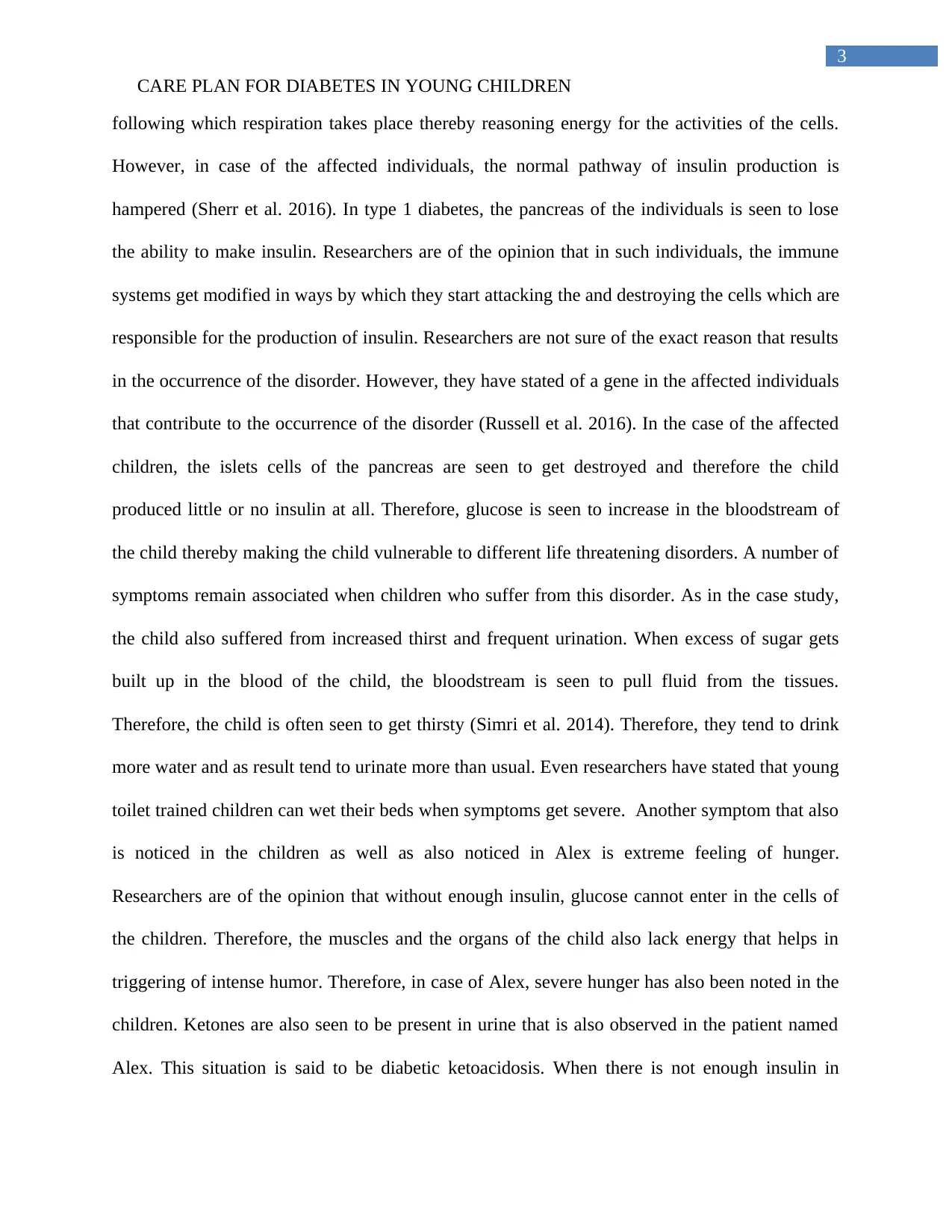
3
CARE PLAN FOR DIABETES IN YOUNG CHILDREN
following which respiration takes place thereby reasoning energy for the activities of the cells.
However, in case of the affected individuals, the normal pathway of insulin production is
hampered (Sherr et al. 2016). In type 1 diabetes, the pancreas of the individuals is seen to lose
the ability to make insulin. Researchers are of the opinion that in such individuals, the immune
systems get modified in ways by which they start attacking the and destroying the cells which are
responsible for the production of insulin. Researchers are not sure of the exact reason that results
in the occurrence of the disorder. However, they have stated of a gene in the affected individuals
that contribute to the occurrence of the disorder (Russell et al. 2016). In the case of the affected
children, the islets cells of the pancreas are seen to get destroyed and therefore the child
produced little or no insulin at all. Therefore, glucose is seen to increase in the bloodstream of
the child thereby making the child vulnerable to different life threatening disorders. A number of
symptoms remain associated when children who suffer from this disorder. As in the case study,
the child also suffered from increased thirst and frequent urination. When excess of sugar gets
built up in the blood of the child, the bloodstream is seen to pull fluid from the tissues.
Therefore, the child is often seen to get thirsty (Simri et al. 2014). Therefore, they tend to drink
more water and as result tend to urinate more than usual. Even researchers have stated that young
toilet trained children can wet their beds when symptoms get severe. Another symptom that also
is noticed in the children as well as also noticed in Alex is extreme feeling of hunger.
Researchers are of the opinion that without enough insulin, glucose cannot enter in the cells of
the children. Therefore, the muscles and the organs of the child also lack energy that helps in
triggering of intense humor. Therefore, in case of Alex, severe hunger has also been noted in the
children. Ketones are also seen to be present in urine that is also observed in the patient named
Alex. This situation is said to be diabetic ketoacidosis. When there is not enough insulin in
CARE PLAN FOR DIABETES IN YOUNG CHILDREN
following which respiration takes place thereby reasoning energy for the activities of the cells.
However, in case of the affected individuals, the normal pathway of insulin production is
hampered (Sherr et al. 2016). In type 1 diabetes, the pancreas of the individuals is seen to lose
the ability to make insulin. Researchers are of the opinion that in such individuals, the immune
systems get modified in ways by which they start attacking the and destroying the cells which are
responsible for the production of insulin. Researchers are not sure of the exact reason that results
in the occurrence of the disorder. However, they have stated of a gene in the affected individuals
that contribute to the occurrence of the disorder (Russell et al. 2016). In the case of the affected
children, the islets cells of the pancreas are seen to get destroyed and therefore the child
produced little or no insulin at all. Therefore, glucose is seen to increase in the bloodstream of
the child thereby making the child vulnerable to different life threatening disorders. A number of
symptoms remain associated when children who suffer from this disorder. As in the case study,
the child also suffered from increased thirst and frequent urination. When excess of sugar gets
built up in the blood of the child, the bloodstream is seen to pull fluid from the tissues.
Therefore, the child is often seen to get thirsty (Simri et al. 2014). Therefore, they tend to drink
more water and as result tend to urinate more than usual. Even researchers have stated that young
toilet trained children can wet their beds when symptoms get severe. Another symptom that also
is noticed in the children as well as also noticed in Alex is extreme feeling of hunger.
Researchers are of the opinion that without enough insulin, glucose cannot enter in the cells of
the children. Therefore, the muscles and the organs of the child also lack energy that helps in
triggering of intense humor. Therefore, in case of Alex, severe hunger has also been noted in the
children. Ketones are also seen to be present in urine that is also observed in the patient named
Alex. This situation is said to be diabetic ketoacidosis. When there is not enough insulin in
Paraphrase This Document
Need a fresh take? Get an instant paraphrase of this document with our AI Paraphraser
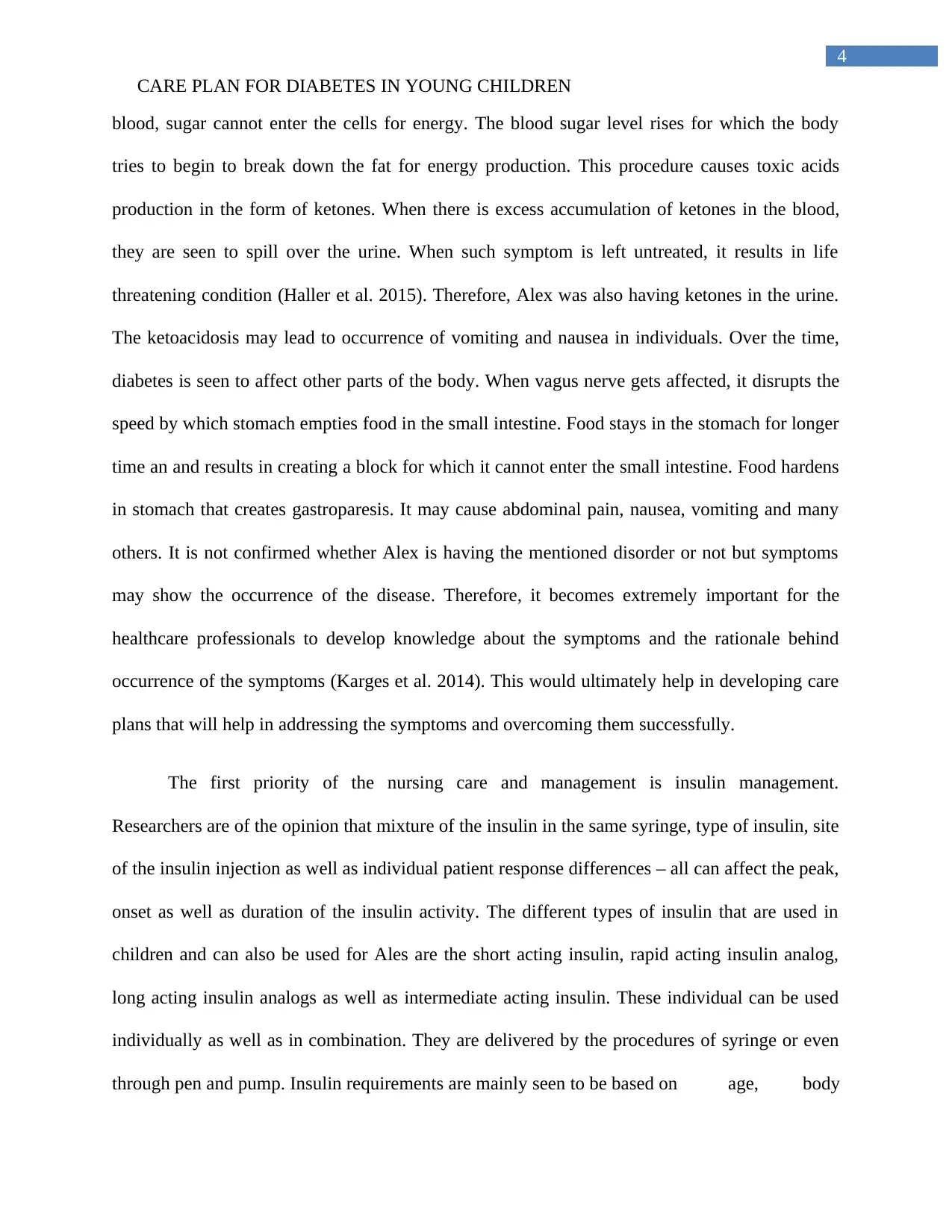
4
CARE PLAN FOR DIABETES IN YOUNG CHILDREN
blood, sugar cannot enter the cells for energy. The blood sugar level rises for which the body
tries to begin to break down the fat for energy production. This procedure causes toxic acids
production in the form of ketones. When there is excess accumulation of ketones in the blood,
they are seen to spill over the urine. When such symptom is left untreated, it results in life
threatening condition (Haller et al. 2015). Therefore, Alex was also having ketones in the urine.
The ketoacidosis may lead to occurrence of vomiting and nausea in individuals. Over the time,
diabetes is seen to affect other parts of the body. When vagus nerve gets affected, it disrupts the
speed by which stomach empties food in the small intestine. Food stays in the stomach for longer
time an and results in creating a block for which it cannot enter the small intestine. Food hardens
in stomach that creates gastroparesis. It may cause abdominal pain, nausea, vomiting and many
others. It is not confirmed whether Alex is having the mentioned disorder or not but symptoms
may show the occurrence of the disease. Therefore, it becomes extremely important for the
healthcare professionals to develop knowledge about the symptoms and the rationale behind
occurrence of the symptoms (Karges et al. 2014). This would ultimately help in developing care
plans that will help in addressing the symptoms and overcoming them successfully.
The first priority of the nursing care and management is insulin management.
Researchers are of the opinion that mixture of the insulin in the same syringe, type of insulin, site
of the insulin injection as well as individual patient response differences – all can affect the peak,
onset as well as duration of the insulin activity. The different types of insulin that are used in
children and can also be used for Ales are the short acting insulin, rapid acting insulin analog,
long acting insulin analogs as well as intermediate acting insulin. These individual can be used
individually as well as in combination. They are delivered by the procedures of syringe or even
through pen and pump. Insulin requirements are mainly seen to be based on age, body
CARE PLAN FOR DIABETES IN YOUNG CHILDREN
blood, sugar cannot enter the cells for energy. The blood sugar level rises for which the body
tries to begin to break down the fat for energy production. This procedure causes toxic acids
production in the form of ketones. When there is excess accumulation of ketones in the blood,
they are seen to spill over the urine. When such symptom is left untreated, it results in life
threatening condition (Haller et al. 2015). Therefore, Alex was also having ketones in the urine.
The ketoacidosis may lead to occurrence of vomiting and nausea in individuals. Over the time,
diabetes is seen to affect other parts of the body. When vagus nerve gets affected, it disrupts the
speed by which stomach empties food in the small intestine. Food stays in the stomach for longer
time an and results in creating a block for which it cannot enter the small intestine. Food hardens
in stomach that creates gastroparesis. It may cause abdominal pain, nausea, vomiting and many
others. It is not confirmed whether Alex is having the mentioned disorder or not but symptoms
may show the occurrence of the disease. Therefore, it becomes extremely important for the
healthcare professionals to develop knowledge about the symptoms and the rationale behind
occurrence of the symptoms (Karges et al. 2014). This would ultimately help in developing care
plans that will help in addressing the symptoms and overcoming them successfully.
The first priority of the nursing care and management is insulin management.
Researchers are of the opinion that mixture of the insulin in the same syringe, type of insulin, site
of the insulin injection as well as individual patient response differences – all can affect the peak,
onset as well as duration of the insulin activity. The different types of insulin that are used in
children and can also be used for Ales are the short acting insulin, rapid acting insulin analog,
long acting insulin analogs as well as intermediate acting insulin. These individual can be used
individually as well as in combination. They are delivered by the procedures of syringe or even
through pen and pump. Insulin requirements are mainly seen to be based on age, body
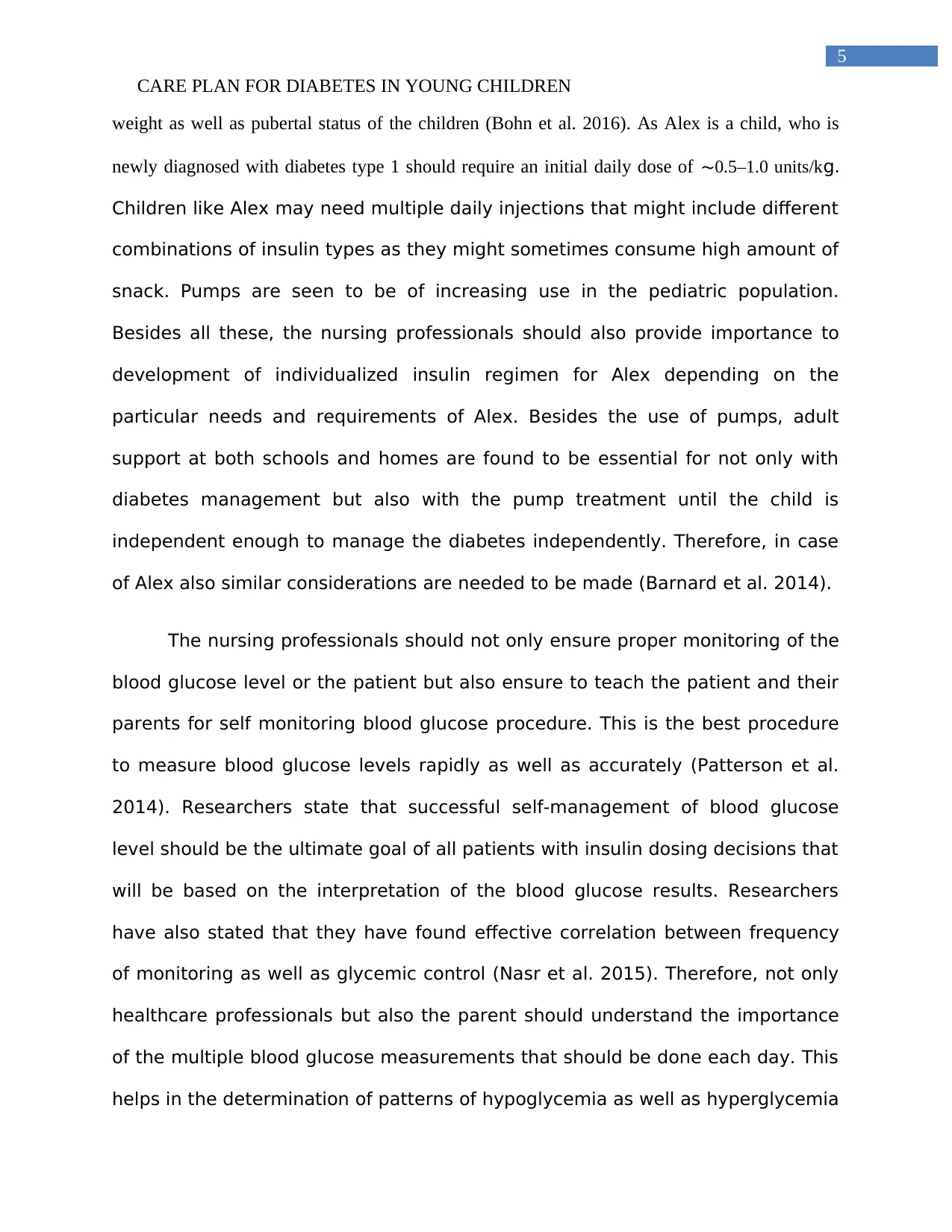
5
CARE PLAN FOR DIABETES IN YOUNG CHILDREN
weight as well as pubertal status of the children (Bohn et al. 2016). As Alex is a child, who is
newly diagnosed with diabetes type 1 should require an initial daily dose of ∼0.5–1.0 units/kg.
Children like Alex may need multiple daily injections that might include different
combinations of insulin types as they might sometimes consume high amount of
snack. Pumps are seen to be of increasing use in the pediatric population.
Besides all these, the nursing professionals should also provide importance to
development of individualized insulin regimen for Alex depending on the
particular needs and requirements of Alex. Besides the use of pumps, adult
support at both schools and homes are found to be essential for not only with
diabetes management but also with the pump treatment until the child is
independent enough to manage the diabetes independently. Therefore, in case
of Alex also similar considerations are needed to be made (Barnard et al. 2014).
The nursing professionals should not only ensure proper monitoring of the
blood glucose level or the patient but also ensure to teach the patient and their
parents for self monitoring blood glucose procedure. This is the best procedure
to measure blood glucose levels rapidly as well as accurately (Patterson et al.
2014). Researchers state that successful self-management of blood glucose
level should be the ultimate goal of all patients with insulin dosing decisions that
will be based on the interpretation of the blood glucose results. Researchers
have also stated that they have found effective correlation between frequency
of monitoring as well as glycemic control (Nasr et al. 2015). Therefore, not only
healthcare professionals but also the parent should understand the importance
of the multiple blood glucose measurements that should be done each day. This
helps in the determination of patterns of hypoglycemia as well as hyperglycemia
CARE PLAN FOR DIABETES IN YOUNG CHILDREN
weight as well as pubertal status of the children (Bohn et al. 2016). As Alex is a child, who is
newly diagnosed with diabetes type 1 should require an initial daily dose of ∼0.5–1.0 units/kg.
Children like Alex may need multiple daily injections that might include different
combinations of insulin types as they might sometimes consume high amount of
snack. Pumps are seen to be of increasing use in the pediatric population.
Besides all these, the nursing professionals should also provide importance to
development of individualized insulin regimen for Alex depending on the
particular needs and requirements of Alex. Besides the use of pumps, adult
support at both schools and homes are found to be essential for not only with
diabetes management but also with the pump treatment until the child is
independent enough to manage the diabetes independently. Therefore, in case
of Alex also similar considerations are needed to be made (Barnard et al. 2014).
The nursing professionals should not only ensure proper monitoring of the
blood glucose level or the patient but also ensure to teach the patient and their
parents for self monitoring blood glucose procedure. This is the best procedure
to measure blood glucose levels rapidly as well as accurately (Patterson et al.
2014). Researchers state that successful self-management of blood glucose
level should be the ultimate goal of all patients with insulin dosing decisions that
will be based on the interpretation of the blood glucose results. Researchers
have also stated that they have found effective correlation between frequency
of monitoring as well as glycemic control (Nasr et al. 2015). Therefore, not only
healthcare professionals but also the parent should understand the importance
of the multiple blood glucose measurements that should be done each day. This
helps in the determination of patterns of hypoglycemia as well as hyperglycemia
⊘ This is a preview!⊘
Do you want full access?
Subscribe today to unlock all pages.

Trusted by 1+ million students worldwide
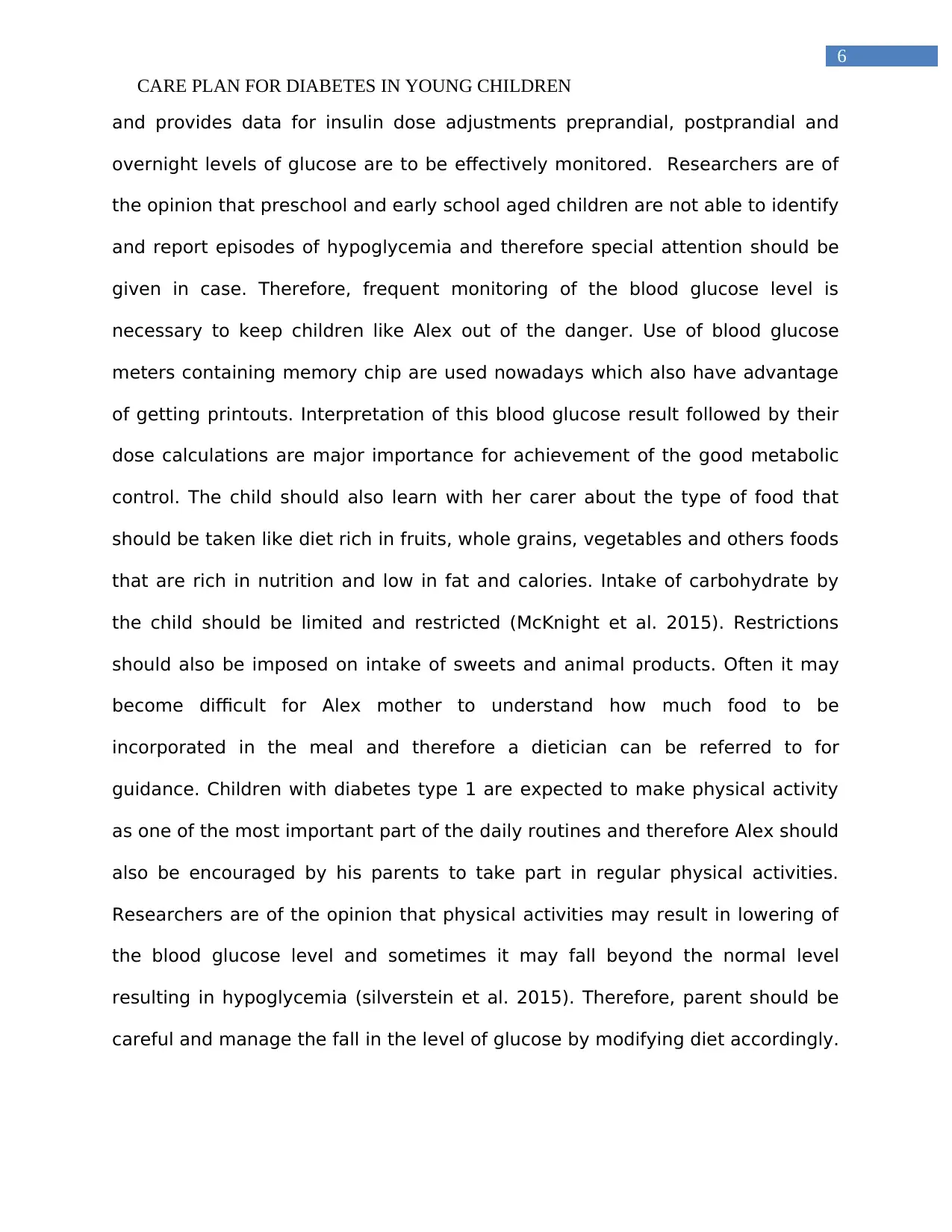
6
CARE PLAN FOR DIABETES IN YOUNG CHILDREN
and provides data for insulin dose adjustments preprandial, postprandial and
overnight levels of glucose are to be effectively monitored. Researchers are of
the opinion that preschool and early school aged children are not able to identify
and report episodes of hypoglycemia and therefore special attention should be
given in case. Therefore, frequent monitoring of the blood glucose level is
necessary to keep children like Alex out of the danger. Use of blood glucose
meters containing memory chip are used nowadays which also have advantage
of getting printouts. Interpretation of this blood glucose result followed by their
dose calculations are major importance for achievement of the good metabolic
control. The child should also learn with her carer about the type of food that
should be taken like diet rich in fruits, whole grains, vegetables and others foods
that are rich in nutrition and low in fat and calories. Intake of carbohydrate by
the child should be limited and restricted (McKnight et al. 2015). Restrictions
should also be imposed on intake of sweets and animal products. Often it may
become difficult for Alex mother to understand how much food to be
incorporated in the meal and therefore a dietician can be referred to for
guidance. Children with diabetes type 1 are expected to make physical activity
as one of the most important part of the daily routines and therefore Alex should
also be encouraged by his parents to take part in regular physical activities.
Researchers are of the opinion that physical activities may result in lowering of
the blood glucose level and sometimes it may fall beyond the normal level
resulting in hypoglycemia (silverstein et al. 2015). Therefore, parent should be
careful and manage the fall in the level of glucose by modifying diet accordingly.
CARE PLAN FOR DIABETES IN YOUNG CHILDREN
and provides data for insulin dose adjustments preprandial, postprandial and
overnight levels of glucose are to be effectively monitored. Researchers are of
the opinion that preschool and early school aged children are not able to identify
and report episodes of hypoglycemia and therefore special attention should be
given in case. Therefore, frequent monitoring of the blood glucose level is
necessary to keep children like Alex out of the danger. Use of blood glucose
meters containing memory chip are used nowadays which also have advantage
of getting printouts. Interpretation of this blood glucose result followed by their
dose calculations are major importance for achievement of the good metabolic
control. The child should also learn with her carer about the type of food that
should be taken like diet rich in fruits, whole grains, vegetables and others foods
that are rich in nutrition and low in fat and calories. Intake of carbohydrate by
the child should be limited and restricted (McKnight et al. 2015). Restrictions
should also be imposed on intake of sweets and animal products. Often it may
become difficult for Alex mother to understand how much food to be
incorporated in the meal and therefore a dietician can be referred to for
guidance. Children with diabetes type 1 are expected to make physical activity
as one of the most important part of the daily routines and therefore Alex should
also be encouraged by his parents to take part in regular physical activities.
Researchers are of the opinion that physical activities may result in lowering of
the blood glucose level and sometimes it may fall beyond the normal level
resulting in hypoglycemia (silverstein et al. 2015). Therefore, parent should be
careful and manage the fall in the level of glucose by modifying diet accordingly.
Paraphrase This Document
Need a fresh take? Get an instant paraphrase of this document with our AI Paraphraser
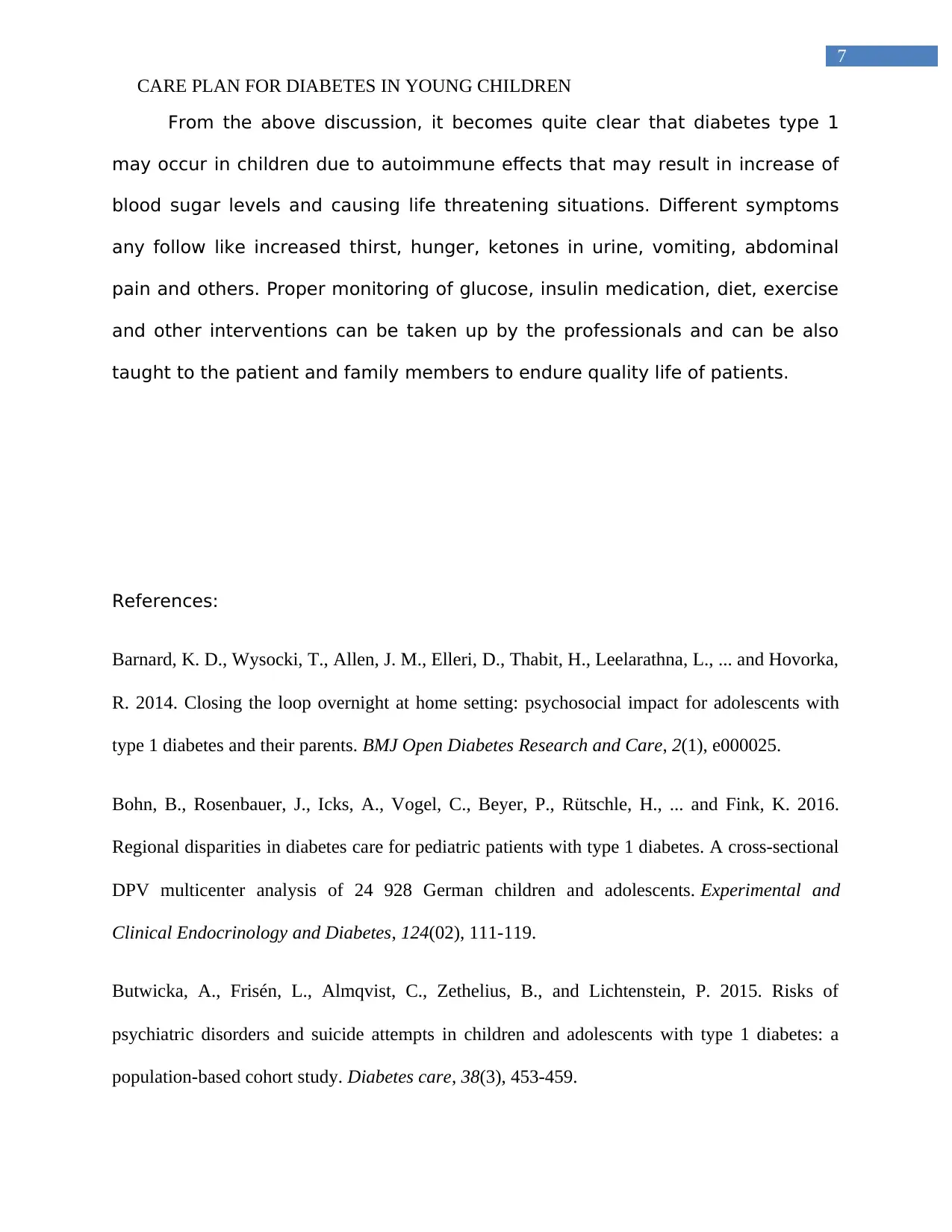
7
CARE PLAN FOR DIABETES IN YOUNG CHILDREN
From the above discussion, it becomes quite clear that diabetes type 1
may occur in children due to autoimmune effects that may result in increase of
blood sugar levels and causing life threatening situations. Different symptoms
any follow like increased thirst, hunger, ketones in urine, vomiting, abdominal
pain and others. Proper monitoring of glucose, insulin medication, diet, exercise
and other interventions can be taken up by the professionals and can be also
taught to the patient and family members to endure quality life of patients.
References:
Barnard, K. D., Wysocki, T., Allen, J. M., Elleri, D., Thabit, H., Leelarathna, L., ... and Hovorka,
R. 2014. Closing the loop overnight at home setting: psychosocial impact for adolescents with
type 1 diabetes and their parents. BMJ Open Diabetes Research and Care, 2(1), e000025.
Bohn, B., Rosenbauer, J., Icks, A., Vogel, C., Beyer, P., Rütschle, H., ... and Fink, K. 2016.
Regional disparities in diabetes care for pediatric patients with type 1 diabetes. A cross-sectional
DPV multicenter analysis of 24 928 German children and adolescents. Experimental and
Clinical Endocrinology and Diabetes, 124(02), 111-119.
Butwicka, A., Frisén, L., Almqvist, C., Zethelius, B., and Lichtenstein, P. 2015. Risks of
psychiatric disorders and suicide attempts in children and adolescents with type 1 diabetes: a
population-based cohort study. Diabetes care, 38(3), 453-459.
CARE PLAN FOR DIABETES IN YOUNG CHILDREN
From the above discussion, it becomes quite clear that diabetes type 1
may occur in children due to autoimmune effects that may result in increase of
blood sugar levels and causing life threatening situations. Different symptoms
any follow like increased thirst, hunger, ketones in urine, vomiting, abdominal
pain and others. Proper monitoring of glucose, insulin medication, diet, exercise
and other interventions can be taken up by the professionals and can be also
taught to the patient and family members to endure quality life of patients.
References:
Barnard, K. D., Wysocki, T., Allen, J. M., Elleri, D., Thabit, H., Leelarathna, L., ... and Hovorka,
R. 2014. Closing the loop overnight at home setting: psychosocial impact for adolescents with
type 1 diabetes and their parents. BMJ Open Diabetes Research and Care, 2(1), e000025.
Bohn, B., Rosenbauer, J., Icks, A., Vogel, C., Beyer, P., Rütschle, H., ... and Fink, K. 2016.
Regional disparities in diabetes care for pediatric patients with type 1 diabetes. A cross-sectional
DPV multicenter analysis of 24 928 German children and adolescents. Experimental and
Clinical Endocrinology and Diabetes, 124(02), 111-119.
Butwicka, A., Frisén, L., Almqvist, C., Zethelius, B., and Lichtenstein, P. 2015. Risks of
psychiatric disorders and suicide attempts in children and adolescents with type 1 diabetes: a
population-based cohort study. Diabetes care, 38(3), 453-459.
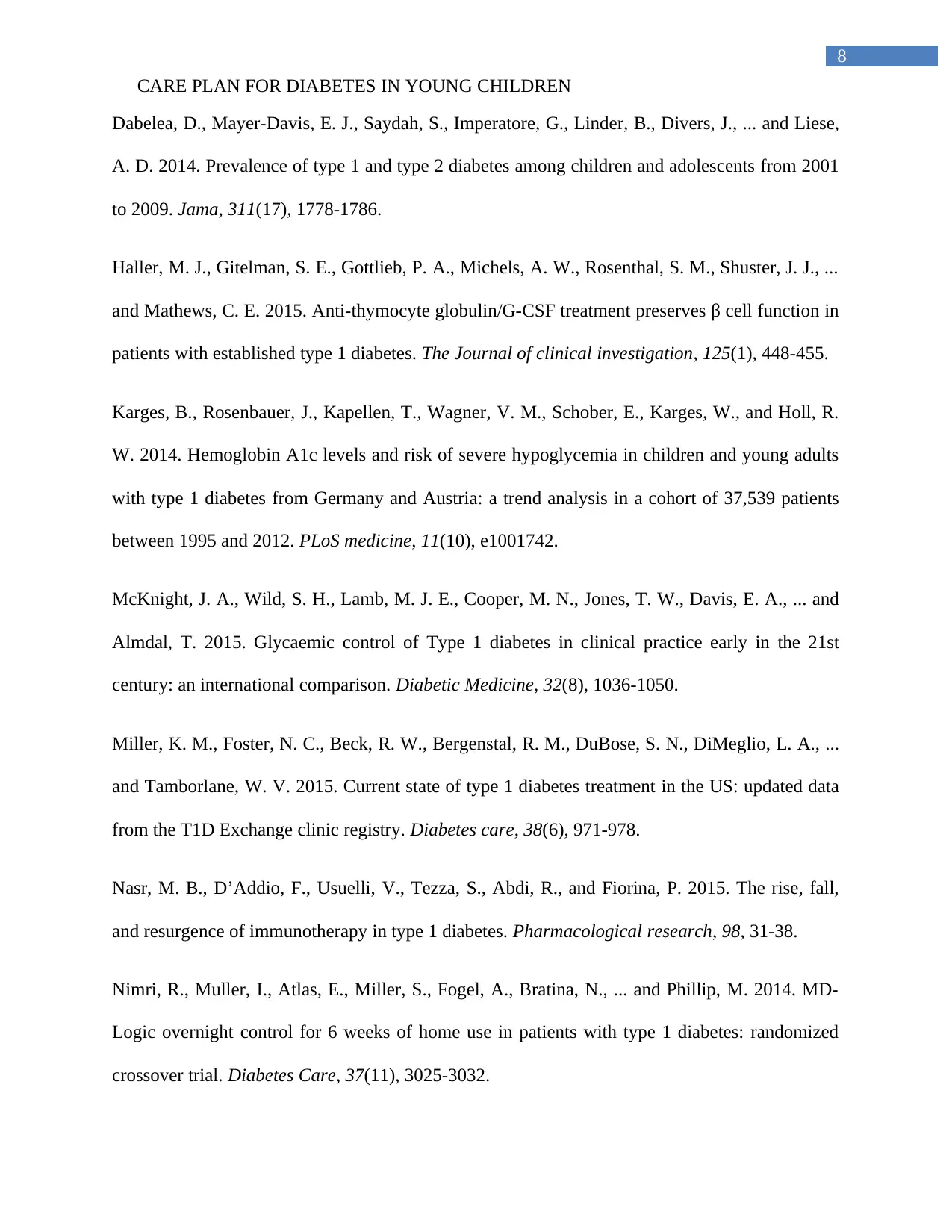
8
CARE PLAN FOR DIABETES IN YOUNG CHILDREN
Dabelea, D., Mayer-Davis, E. J., Saydah, S., Imperatore, G., Linder, B., Divers, J., ... and Liese,
A. D. 2014. Prevalence of type 1 and type 2 diabetes among children and adolescents from 2001
to 2009. Jama, 311(17), 1778-1786.
Haller, M. J., Gitelman, S. E., Gottlieb, P. A., Michels, A. W., Rosenthal, S. M., Shuster, J. J., ...
and Mathews, C. E. 2015. Anti-thymocyte globulin/G-CSF treatment preserves β cell function in
patients with established type 1 diabetes. The Journal of clinical investigation, 125(1), 448-455.
Karges, B., Rosenbauer, J., Kapellen, T., Wagner, V. M., Schober, E., Karges, W., and Holl, R.
W. 2014. Hemoglobin A1c levels and risk of severe hypoglycemia in children and young adults
with type 1 diabetes from Germany and Austria: a trend analysis in a cohort of 37,539 patients
between 1995 and 2012. PLoS medicine, 11(10), e1001742.
McKnight, J. A., Wild, S. H., Lamb, M. J. E., Cooper, M. N., Jones, T. W., Davis, E. A., ... and
Almdal, T. 2015. Glycaemic control of Type 1 diabetes in clinical practice early in the 21st
century: an international comparison. Diabetic Medicine, 32(8), 1036-1050.
Miller, K. M., Foster, N. C., Beck, R. W., Bergenstal, R. M., DuBose, S. N., DiMeglio, L. A., ...
and Tamborlane, W. V. 2015. Current state of type 1 diabetes treatment in the US: updated data
from the T1D Exchange clinic registry. Diabetes care, 38(6), 971-978.
Nasr, M. B., D’Addio, F., Usuelli, V., Tezza, S., Abdi, R., and Fiorina, P. 2015. The rise, fall,
and resurgence of immunotherapy in type 1 diabetes. Pharmacological research, 98, 31-38.
Nimri, R., Muller, I., Atlas, E., Miller, S., Fogel, A., Bratina, N., ... and Phillip, M. 2014. MD-
Logic overnight control for 6 weeks of home use in patients with type 1 diabetes: randomized
crossover trial. Diabetes Care, 37(11), 3025-3032.
CARE PLAN FOR DIABETES IN YOUNG CHILDREN
Dabelea, D., Mayer-Davis, E. J., Saydah, S., Imperatore, G., Linder, B., Divers, J., ... and Liese,
A. D. 2014. Prevalence of type 1 and type 2 diabetes among children and adolescents from 2001
to 2009. Jama, 311(17), 1778-1786.
Haller, M. J., Gitelman, S. E., Gottlieb, P. A., Michels, A. W., Rosenthal, S. M., Shuster, J. J., ...
and Mathews, C. E. 2015. Anti-thymocyte globulin/G-CSF treatment preserves β cell function in
patients with established type 1 diabetes. The Journal of clinical investigation, 125(1), 448-455.
Karges, B., Rosenbauer, J., Kapellen, T., Wagner, V. M., Schober, E., Karges, W., and Holl, R.
W. 2014. Hemoglobin A1c levels and risk of severe hypoglycemia in children and young adults
with type 1 diabetes from Germany and Austria: a trend analysis in a cohort of 37,539 patients
between 1995 and 2012. PLoS medicine, 11(10), e1001742.
McKnight, J. A., Wild, S. H., Lamb, M. J. E., Cooper, M. N., Jones, T. W., Davis, E. A., ... and
Almdal, T. 2015. Glycaemic control of Type 1 diabetes in clinical practice early in the 21st
century: an international comparison. Diabetic Medicine, 32(8), 1036-1050.
Miller, K. M., Foster, N. C., Beck, R. W., Bergenstal, R. M., DuBose, S. N., DiMeglio, L. A., ...
and Tamborlane, W. V. 2015. Current state of type 1 diabetes treatment in the US: updated data
from the T1D Exchange clinic registry. Diabetes care, 38(6), 971-978.
Nasr, M. B., D’Addio, F., Usuelli, V., Tezza, S., Abdi, R., and Fiorina, P. 2015. The rise, fall,
and resurgence of immunotherapy in type 1 diabetes. Pharmacological research, 98, 31-38.
Nimri, R., Muller, I., Atlas, E., Miller, S., Fogel, A., Bratina, N., ... and Phillip, M. 2014. MD-
Logic overnight control for 6 weeks of home use in patients with type 1 diabetes: randomized
crossover trial. Diabetes Care, 37(11), 3025-3032.
⊘ This is a preview!⊘
Do you want full access?
Subscribe today to unlock all pages.

Trusted by 1+ million students worldwide
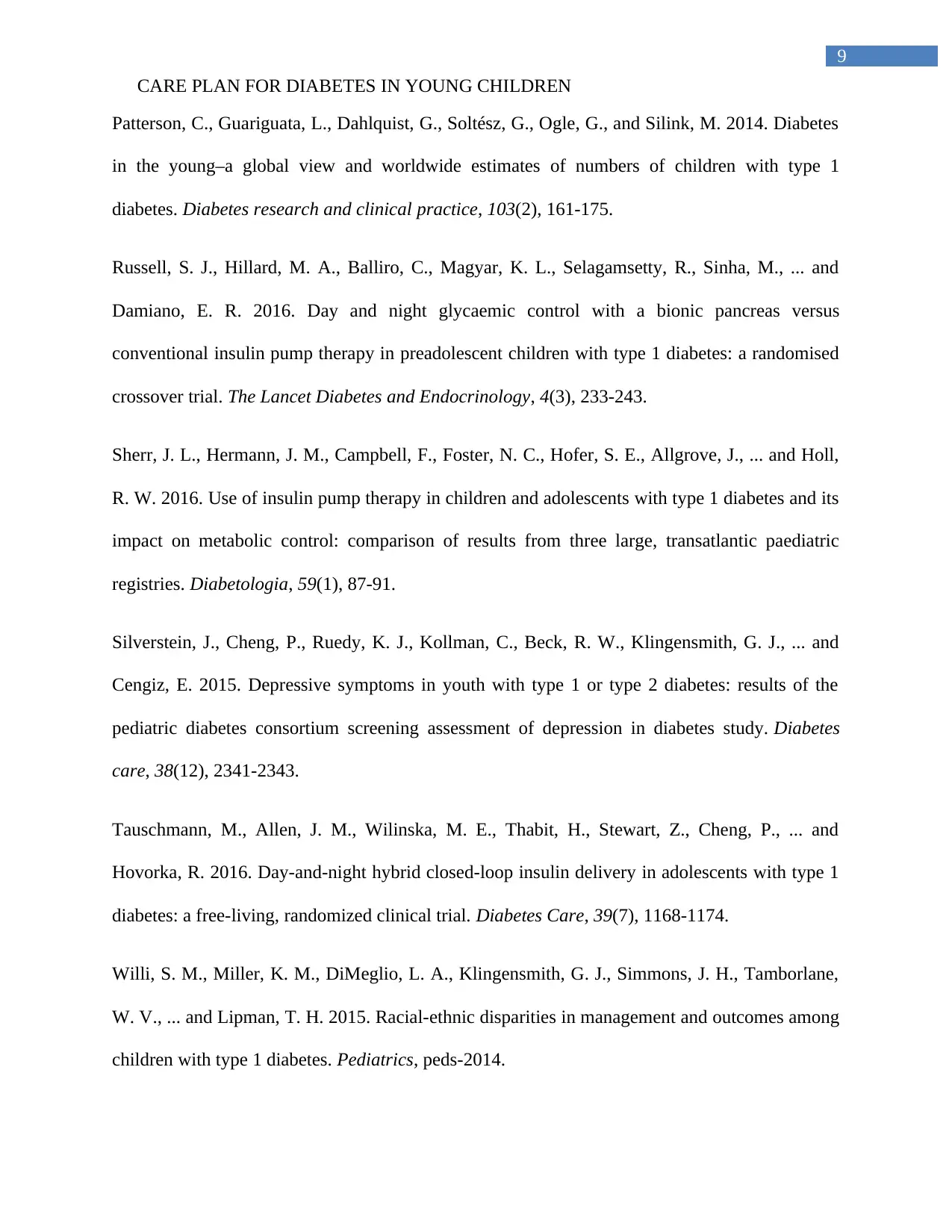
9
CARE PLAN FOR DIABETES IN YOUNG CHILDREN
Patterson, C., Guariguata, L., Dahlquist, G., Soltész, G., Ogle, G., and Silink, M. 2014. Diabetes
in the young–a global view and worldwide estimates of numbers of children with type 1
diabetes. Diabetes research and clinical practice, 103(2), 161-175.
Russell, S. J., Hillard, M. A., Balliro, C., Magyar, K. L., Selagamsetty, R., Sinha, M., ... and
Damiano, E. R. 2016. Day and night glycaemic control with a bionic pancreas versus
conventional insulin pump therapy in preadolescent children with type 1 diabetes: a randomised
crossover trial. The Lancet Diabetes and Endocrinology, 4(3), 233-243.
Sherr, J. L., Hermann, J. M., Campbell, F., Foster, N. C., Hofer, S. E., Allgrove, J., ... and Holl,
R. W. 2016. Use of insulin pump therapy in children and adolescents with type 1 diabetes and its
impact on metabolic control: comparison of results from three large, transatlantic paediatric
registries. Diabetologia, 59(1), 87-91.
Silverstein, J., Cheng, P., Ruedy, K. J., Kollman, C., Beck, R. W., Klingensmith, G. J., ... and
Cengiz, E. 2015. Depressive symptoms in youth with type 1 or type 2 diabetes: results of the
pediatric diabetes consortium screening assessment of depression in diabetes study. Diabetes
care, 38(12), 2341-2343.
Tauschmann, M., Allen, J. M., Wilinska, M. E., Thabit, H., Stewart, Z., Cheng, P., ... and
Hovorka, R. 2016. Day-and-night hybrid closed-loop insulin delivery in adolescents with type 1
diabetes: a free-living, randomized clinical trial. Diabetes Care, 39(7), 1168-1174.
Willi, S. M., Miller, K. M., DiMeglio, L. A., Klingensmith, G. J., Simmons, J. H., Tamborlane,
W. V., ... and Lipman, T. H. 2015. Racial-ethnic disparities in management and outcomes among
children with type 1 diabetes. Pediatrics, peds-2014.
CARE PLAN FOR DIABETES IN YOUNG CHILDREN
Patterson, C., Guariguata, L., Dahlquist, G., Soltész, G., Ogle, G., and Silink, M. 2014. Diabetes
in the young–a global view and worldwide estimates of numbers of children with type 1
diabetes. Diabetes research and clinical practice, 103(2), 161-175.
Russell, S. J., Hillard, M. A., Balliro, C., Magyar, K. L., Selagamsetty, R., Sinha, M., ... and
Damiano, E. R. 2016. Day and night glycaemic control with a bionic pancreas versus
conventional insulin pump therapy in preadolescent children with type 1 diabetes: a randomised
crossover trial. The Lancet Diabetes and Endocrinology, 4(3), 233-243.
Sherr, J. L., Hermann, J. M., Campbell, F., Foster, N. C., Hofer, S. E., Allgrove, J., ... and Holl,
R. W. 2016. Use of insulin pump therapy in children and adolescents with type 1 diabetes and its
impact on metabolic control: comparison of results from three large, transatlantic paediatric
registries. Diabetologia, 59(1), 87-91.
Silverstein, J., Cheng, P., Ruedy, K. J., Kollman, C., Beck, R. W., Klingensmith, G. J., ... and
Cengiz, E. 2015. Depressive symptoms in youth with type 1 or type 2 diabetes: results of the
pediatric diabetes consortium screening assessment of depression in diabetes study. Diabetes
care, 38(12), 2341-2343.
Tauschmann, M., Allen, J. M., Wilinska, M. E., Thabit, H., Stewart, Z., Cheng, P., ... and
Hovorka, R. 2016. Day-and-night hybrid closed-loop insulin delivery in adolescents with type 1
diabetes: a free-living, randomized clinical trial. Diabetes Care, 39(7), 1168-1174.
Willi, S. M., Miller, K. M., DiMeglio, L. A., Klingensmith, G. J., Simmons, J. H., Tamborlane,
W. V., ... and Lipman, T. H. 2015. Racial-ethnic disparities in management and outcomes among
children with type 1 diabetes. Pediatrics, peds-2014.
Paraphrase This Document
Need a fresh take? Get an instant paraphrase of this document with our AI Paraphraser

10
CARE PLAN FOR DIABETES IN YOUNG CHILDREN
CARE PLAN FOR DIABETES IN YOUNG CHILDREN
1 out of 11
Related Documents
Your All-in-One AI-Powered Toolkit for Academic Success.
+13062052269
info@desklib.com
Available 24*7 on WhatsApp / Email
![[object Object]](/_next/static/media/star-bottom.7253800d.svg)
Unlock your academic potential
Copyright © 2020–2025 A2Z Services. All Rights Reserved. Developed and managed by ZUCOL.





